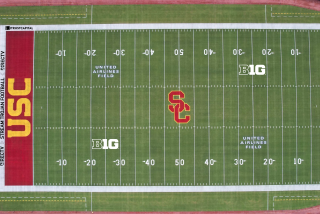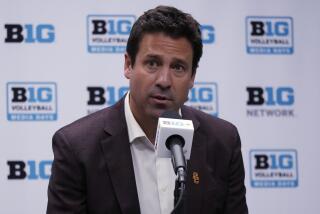Pac-12 hopes to battle Big Ten as network stars
- Share via
Last weekend, USC women’s volleyball Coach Mick Haley was in Phoenix, where his Trojans were to play Arizona State. And what he saw on television frustrated him.
“I’m in a Pac-10 city,” Haley said, “and I couldn’t find any Pac-10 sports. I’m watching Minnesota play Penn State in volleyball and doing the color is Kelli Tennant. That’s one of our former players and she was really good, she was using all my coaching axioms and I’m just about having a coronary. The Big Ten has really leveled the playing field in recruiting, getting the pick of kids now because of the Big Ten Network.”
Maybe not for long.
On Thursday in San Francisco, Pacific 10 Conference Commissioner Larry Scott will hold a news conference to discuss how the soon-to-be Pac-12 will realign with newcomers Colorado and Utah.
Critical to the success of that expansion, though, will be new television contracts that Scott will negotiate beginning next year. Current deals with Fox and ABC/ESPN are worth $53 million a year to the conference but could more than triple if the Big Ten is any indication.
Scott has made clear he wants to elevate the Pac-12 conference in the national consciousness in a rebranding campaign — delivering more national exposure and, in turn, more lucrative rights fees. And he is looking at the Big Ten Network as a kind of blueprint.
The reason is simple: The Big Ten Network is thriving. Seen as a novel idea when it was launched three years ago, the network’s success has been stunning.
Of the top 20 U.S. markets, the Big Ten Network is in 19, including Los Angeles. It has 48 million paid subscribers and a $230-million operating budget. Though the network cost the Big Ten more than $56 million during its first year on the air, it is projected to make the conference more than $87 million in 2011, according to the media research company SNL Kagan.
That projected revenue would be in addition to the $110 million the conference gets from its TV contract with ABC/ESPN through 2016.
Another unexpected benefit of the Big Ten Network? Recruiting.
UCLA women’s basketball Coach Nikki Caldwell, aiming to build a program that is nationally competitive, said she has found herself trying to sell the benefits of going to school in Los Angeles, getting a high-quality education but being asked to counter the simple statement jam-packed with what can seem so important to a teenager. “They all want to be on television,” Caldwell said.
There is little doubt that the Pac-12 will make big gains in any new TV deals and that some combination of networks — Fox, ESPN and Comcast will be likely bidders — could be worth as much as $100 million. That revenue could jump to $172 million a year if a Pac-12 Network can be sold, according to the media research firm Navigate Marketing.
Derek Baine, senior analyst covering television networks for the Charlottesville, Va.-based SNL Kagan, isn’t sure it can be sold right now. He points to the ugly contract disputes between cable television carriers and network content providers that have recently left customers of Dish Network and Cablevision missing major sporting events.
“The timing right now is terrible to launch a cable network,” Baine said. “You’d have to wait until things simmer down but I don’t think that happens any time soon. I just don’t see the reincarnation of the Big Ten Network any time soon.”
Not surprisingly, Kevin Weiberg, the Pac-10’s deputy commissioner, disagrees.
“We’re a conference with really good content that we’re taking directly to distributors,” said Weiberg, former commissioner of the Big 12 and a member of the Big Ten commission that created the Big Ten Network. “We would respectfully disagree with the idea that there’s not room for our network.
“The multimedia world continues to change. Elements such as digital platforms are more prominent now, video on demand, other things in the basic equation.”
AJ Maestas is president of Navigate Marketing, a Chicago-based firm specializing in research, valuation and sponsorship return on investment. Among its clients are ESPN, the NFL and AEG. Navigate has taken the Big Ten’s current television revenue and compared that to projected revenue from the Pac-12’s future deals.
In those numbers, each Big Ten school (the conference splits television revenues equally) receives $20 million per year.
According to Navigate’s projections, if the Pac-12 did get a $172-million deal and if revenue was shared equally among the schools, each would get about $14 million a year.
In the present configuration, in which USC and UCLA get larger percentages of television revenue, Navigate estimated that USC would get $20 million a year, UCLA about $16 million; Stanford, at the bottom, would get $12 million.
“The idea of the Pac-10 network is a virtual certainty,” Maestas said. “It will be less of an economic decision than people think. It’s as much a branding and recruiting decision.”
Neal Pilson, former president of CBS Sports and now a television consultant, thinks the Pac-12 is on to something.
“The Big Ten Network is universally seen as a very big success,” Pilson said. “It wasn’t immediate, there were growth pains and early distribution issues but it has grown gradually into a significant national network.
“Obviously it’s a different economic climate. But I think the league is on the right track, not just creating a network for its base states but looking to extend that network into the Midwest, South, Northeast.”
twitter.com/mepucin
More to Read
Fight on! Are you a true Trojans fan?
Get our Times of Troy newsletter for USC insights, news and much more.
You may occasionally receive promotional content from the Los Angeles Times.






